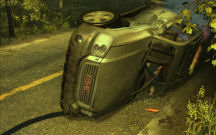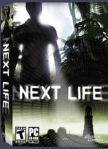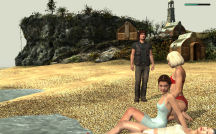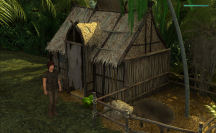Do you remember that childhood game
where you snatch up a hapless daisy and pull off the petals one by one,
intoning “He loves me, he loves me not”? Next Life reminds me of
this.
I grab a virtual daisy (don’t want to hurt real flowers,
do we!) and brandish it in my mind while I consider the possibilities. I
love it; the story is an unusual idea. I love it not; the pixel hunting is
annoying. I love it; the character models are outstanding. I love it not;
the puzzles and arcade are a nightmare. I love it; the ambient sounds
transport you to the strange island. I love it not; there is little music
in the game.
Several daisies later, I have to concede that my
expectations for this game from the developers of Black Mirror were
too high. This feels like a game that was completed prior to Black
Mirror, with none of the polish and flow that made that game such an
instant favorite. Still, there are moments in Next Life that remind
the gamer of how very good these developers can be, and ultimately I did
have fun with most of it.
“My name is Adam and I come from Bohemia.”--Next
Life
The game begins with a cut scene showing the main
character, Adam Raichl, getting in his vehicle. He is temporarily blinded
by a white light but shakes it off and speeds down a dark road. Grabbing a
cell phone to tell someone he’s on the way to them, he ignores a yield
sign and runs into a gasoline tanker truck. A big explosion occurs, and
the next scene shows Adam unhurt but in a different location entirely.
This is where we gain control of Adam in this third person perspective
game.
Adam finds himself in a weather-beaten metal hut on a
lovely island in the middle of nowhere. As Adam, we explore our new
surroundings and meet other people who don’t have any idea why they are on
this strange island either. Each person has been in a horrific accident
and has arrived at this exotic locale unscathed. They come from different
countries and different circumstances, and some from different time periods
as well. Adam has to interact with them all in an attempt to answer why he
is there and how he can leave the island to get on with his life. A
motivating factor for leaving is that everyone has nightmares on the
island, and it becomes apparent that one’s actions in a dream may have
very real consequences.
The screens are static with no panning, though there is
movement within them, with a seagull swooping gracefully by or waves
lapping at the shore. The 2.5D graphics are quite nice, and are greatly
enhanced by the excellent ambient sound. The wind whistles, seagulls caw,
and rocks thrown into the water make a satisfying splash. In a nightmare
sequence, liquid falling on construction pipes is well done and serves to
make the atmosphere eerie. What little music there is in the game is
unobtrusive.
“I did not pay for a holiday in the Caribbean as
far as I know.”--Next Life
There’s a kind of oddball charm to the main character’s
accented and stilted English, and I found him quite likable. The varying
accents of those he meets serve to enhance their somewhat stereotypical
characters, and good voice work makes them come to life. The excellent 3D
character graphics made me feel like I was meeting real individuals, each
with strengths and flaws. From the kind-hearted American to the womanizing
German to the crafty Scot, I enjoyed the banter (although occasionally it
didn’t make much sense).
There isn’t as much dialog as I would have liked, but
there is just enough to move the story along. Adam often makes comments
that give a clue to what your next action should be. On the other hand,
Adam sometimes makes comments that don’t seem to apply to the situation in
the least. Salty language is sprinkled here and there. There is partial
nudity in one scene, which I thought was tastefully done and one toilet
scene with accompanying toilet humor which I could have lived without.
Somewhat less charming are the awkward subtitle
translations. These are filled with incorrect English and sometimes don't
match the spoken word. This strangeness also appears on-screen when
identifying locations, which are named “under the hill,” and “at the gap,”
and so on.
While on the topic of locations, it might be pertinent
to divulge the fact that I always read the game manual. Unfortunately, in
games for review, I have the habit of reading it after I play the game for
the first time. This way I can judge if it is particularly helpful or
innovative in some way. If I had read the manual prior to playing Next
Life, I would have had fewer hair-pulling moments. Important to note
in regard to this game is that the exits on the screen can be revealed by
pressing the “E” key on your keyboard. There are entirely too many pixel
hunts already -- when picking up inventory, for instance, and especially
when accessing a climbing icon for negotiating difficult terrain --
without adding to the equation.
“Locked! Who would have thought so?”—Next Life
Most of the puzzles consist of picking up items that one
might readily find in the surroundings and utilizing them to solve a
puzzle (although there is an exception or two). Occasionally items need to
be combined in inventory before they can be used on-screen. Sometimes it
is necessary to right-click an item in inventory to gain information from
it. While on the one hand it makes sense to use sticks and rocks on the
island to gain your objective, it becomes tedious to continue doing this
over and over again. When puzzles were available that used other
components, they were significantly more interesting.
The game is linear, and you may have to find a character
and initiate a dialog before a puzzle can be continued. The other
characters do not stay in one place; considerable searching for them may
ensue. I liked this facet of the game, with the individuals going about
their lives -- one jogging, one trying to trap a bird, one ogling another.
Each new day in this game world has the camera angles changing, so you
will have to reorient yourself to available locations.
Sometimes an article is too large to fit into Adam’s
pocket (your inventory), and has to be utilized in that same screen. This
can be problematic when nothing appears to be an item with which you can
interact, but that item only becomes active once you have climbed to a
certain position by way of the ascent icon (which in turn is not always
easy to locate on the screen).
Adam can die by failing at some puzzles, but the game
will automatically take you back to the sequence before you made a
mistake. It is still a very good idea to save often, because repeating
these sequences can be a long process, especially if there are cut scenes
involved. Outside of cut scenes, the game can be saved anywhere -- even in
the middle of a puzzle. There are ample saves and it is beneficial to make
use of them.
“A stamp collection would be more pleasant at this
point.”—Next Life
However, in the midst of this slowly emerging story, you
are suddenly in one of Adam’s nightmares and are facing a timed arcade
sequence without any explanation as to the objective or the rules of the
game. There are three of these sequences. I had to ask elsewhere for help
with what I was supposed to do when I encountered the first one. Once I
understood it, I was able to complete it easily with my weak hand on the
keyboard.
I have played many action-type games, so a pure
adventure gamer may find this more difficult. But stunningly, the second
and the third such sequence were difficult for me to complete, and I had
to keep trying many times before I was successful. A bypass key or an
automatic win after a certain number of tries should have been implemented
here. This almost certainly will be a game stopper for some gamers who
find that they are required to go from the point-and-click interface of
the main game to a keyboard arrow frenzy -- even if they haven’t the
ability or the inclination to do so.
After a failed attempt, you are returned to the
beginning of the sequence. On the third such puzzle, that return takes you
to the beginning of a particularly long combination of exploration and
inventory acquisition and implementation with another timed aspect to it
(although there is ample time to successfully conclude that part once
appropriate steps are taken). Again, it is very important to save often.
There are at least two other times in the game when it
is necessary to have a quick response, but they don't differ from what you
would find in many other adventure games. One of these quick reaction
sequences does require you to hide without indicating an icon to do so.
“I regret for the first time in my life that I am
not Spiderman”—Next Life
I experienced no crashes or bugs with this game. There
is a strange quirk, however, when on occasion the game seems to pause as
an action is initiated. In addition, twice my character had to stand in
place doing nothing until the storyline kicked in -- once in a cave and
once toward the end of the game.
A double-click makes Adam go to the next screen more
quickly. Given that there is no map for fast travel and a lot of going
back and forth between characters and locations, this is a welcome
feature. However, by having Adam “run” by double-clicking, you also reduce
his stamina, which is reflected in a bar at the top of the game screen.
Usually this doesn’t matter, but there are times when Adam may announce
that he is too tired to do a certain action. At that point he needs to
drink water or eat cookies.
“A morgue? What’s next? A cemetery and a crazy
grave digger?”—Next Life
This is an interesting story with a twist. But I’m not
sure gamers will get to that point due to the aforementioned pixel
hunting, the shock of going from a slow point-and-click pace to timed
arcade sequences with keyboard arrows, and other oddities. However, I
enjoyed the story, especially getting to know the diverse, life-like
characters -- each with a unique, tragic tale.
B-
December 2007
design copyright ©
2007
GameBoomers
Group




